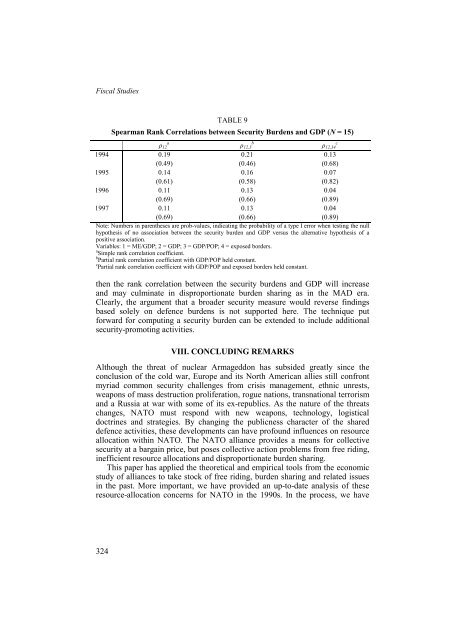Fiscal StudiesTABLE 9Spearman Rank Correlations between Security Burdens <strong>and</strong> GDP (N = 15)ρ 12aρ 12,3bρ 12,34c1994 0.19(0.49)0.21(0.46)0.13(0.68)1995 0.14(0.61)0.16(0.58)0.07(0.82)1996 0.11(0.69)0.13(0.66)0.04(0.89)1997 0.11(0.69)0.13(0.66)0.04(0.89)Note: Numbers <strong>in</strong> paren<strong>the</strong>ses are prob-values, <strong>in</strong>dicat<strong>in</strong>g <strong>the</strong> probability of a type I error when test<strong>in</strong>g <strong>the</strong> nullhypo<strong>the</strong>sis of no association between <strong>the</strong> security burden <strong>and</strong> GDP versus <strong>the</strong> alternative hypo<strong>the</strong>sis of apositive association.Variables: 1 = ME/GDP; 2 = GDP; 3 = GDP/POP; 4 = exposed borders.a Simple rank correlation coefficient.b Partial rank correlation coefficient with GDP/POP held constant.c Partial rank correlation coefficient with GDP/POP <strong>and</strong> exposed borders held constant.<strong>the</strong>n <strong>the</strong> rank correlation between <strong>the</strong> security <strong>burdens</strong> <strong>and</strong> GDP will <strong>in</strong>crease<strong>and</strong> may culm<strong>in</strong>ate <strong>in</strong> disproportionate burden <strong>shar<strong>in</strong>g</strong> as <strong>in</strong> <strong>the</strong> MAD era.Clearly, <strong>the</strong> argument that a broader security measure would reverse f<strong>in</strong>d<strong>in</strong>gsbased solely on <strong>defence</strong> <strong>burdens</strong> is not supported here. The technique putforward for comput<strong>in</strong>g a security burden can be extended to <strong>in</strong>clude additionalsecurity-promot<strong>in</strong>g activities.VIII. CONCLUDING REMARKSAlthough <strong>the</strong> threat of nuclear Armageddon has subsided greatly s<strong>in</strong>ce <strong>the</strong>conclusion of <strong>the</strong> cold war, Europe <strong>and</strong> its North American allies still confrontmyriad common security challenges from crisis management, ethnic unrests,weapons of mass destruction proliferation, rogue nations, transnational terrorism<strong>and</strong> a Russia at war with some of its ex-republics. As <strong>the</strong> nature of <strong>the</strong> threatschanges, <strong>NATO</strong> must respond with new weapons, technology, logisticaldoctr<strong>in</strong>es <strong>and</strong> strategies. By chang<strong>in</strong>g <strong>the</strong> publicness character of <strong>the</strong> shared<strong>defence</strong> activities, <strong>the</strong>se developments can have profound <strong>in</strong>fluences on resourceallocation with<strong>in</strong> <strong>NATO</strong>. The <strong>NATO</strong> alliance provides a means for collectivesecurity at a barga<strong>in</strong> price, but poses collective action problems from free rid<strong>in</strong>g,<strong>in</strong>efficient resource allocations <strong>and</strong> disproportionate burden <strong>shar<strong>in</strong>g</strong>.This paper has applied <strong>the</strong> <strong>the</strong>oretical <strong>and</strong> empirical tools from <strong>the</strong> economicstudy of alliances to take stock of free rid<strong>in</strong>g, burden <strong>shar<strong>in</strong>g</strong> <strong>and</strong> related issues<strong>in</strong> <strong>the</strong> past. More important, we have provided an up-to-date analysis of <strong>the</strong>seresource-allocation concerns for <strong>NATO</strong> <strong>in</strong> <strong>the</strong> <strong>1990s</strong>. In <strong>the</strong> process, we have324
Shar<strong>in</strong>g <strong>NATO</strong> Defence Burdensshown that <strong>the</strong> jo<strong>in</strong>t product model still applies dur<strong>in</strong>g <strong>the</strong> current crisismanagementera. There cont<strong>in</strong>ues to be a concordance between benefits received<strong>and</strong> <strong>defence</strong> <strong>burdens</strong> borne by <strong>the</strong> allies. Moreover, <strong>the</strong>re is no evidence yet ofdisproportionate <strong>burdens</strong> be<strong>in</strong>g shouldered by <strong>the</strong> large allies. At this po<strong>in</strong>t <strong>in</strong>time, <strong>NATO</strong>’s loosely <strong>in</strong>tegrated <strong>in</strong>stitutional structure <strong>the</strong>refore rema<strong>in</strong>sappropriate. Never<strong>the</strong>less, <strong>the</strong>oretical arguments are put forward that hypo<strong>the</strong>sisethat <strong>defence</strong> burden <strong>shar<strong>in</strong>g</strong> will become more disproportionately carried by <strong>the</strong>large allies <strong>in</strong> <strong>the</strong> future as spend<strong>in</strong>g on crisis management, force mobility,weapons non-proliferation <strong>and</strong> high-technology weapons <strong>in</strong>creases as aproportion of <strong>the</strong> <strong>defence</strong> budget. If this prediction is realised, <strong>the</strong>n <strong>NATO</strong>’s<strong>in</strong>stitutional structure may need to be tightened <strong>and</strong>, <strong>in</strong> so do<strong>in</strong>g, allies’discretion will be reduced.We have also presented alternative <strong>NATO</strong> expansion scenarios that mayresult <strong>in</strong> an <strong>in</strong>creased exploitation of <strong>the</strong> large by <strong>the</strong> small if <strong>the</strong> alliancecont<strong>in</strong>ues to exp<strong>and</strong>. It would be useful to re-exam<strong>in</strong>e <strong>NATO</strong>’s <strong>burdens</strong> <strong>in</strong>ano<strong>the</strong>r five years to evaluate if <strong>the</strong> predicted trend to disproportionate burden<strong>shar<strong>in</strong>g</strong> <strong>and</strong> a greater share of purely public output is realised.REFERENCESAsmus, R. D. (1997), ‘Double enlargement: redef<strong>in</strong><strong>in</strong>g <strong>the</strong> Atlantic partnership after <strong>the</strong> Cold War’,<strong>in</strong> D. C. Gompert <strong>and</strong> F. S. Larrabee (eds), America <strong>and</strong> Europe: A Partnership for a New Era,Cambridge: Cambridge University Press.Enders, W. <strong>and</strong> S<strong>and</strong>ler, T. (1999), ‘Transnational terrorism <strong>in</strong> <strong>the</strong> post-Cold War era’,International Studies Quarterly, vol. 43, pp. 145–67.— <strong>and</strong> — (2000), ‘Is transnational terrorism becom<strong>in</strong>g more threaten<strong>in</strong>g? A time series<strong>in</strong>vestigation’, Journal of Conflict Resolution, vol. 44, pp. 307–32.Gardner, R. (1995), Games for Bus<strong>in</strong>ess <strong>and</strong> Economics, New York: John Wiley & Sons.Gompert, D. C. <strong>and</strong> Larrabee, F. S. (eds) (1997), America <strong>and</strong> Europe: A Partnership for a NewEra, Cambridge: Cambridge University Press.Hartley, K. (1997), ‘The Cold War, great-power traditions <strong>and</strong> military posture: determ<strong>in</strong>ants ofBritish <strong>defence</strong> expenditure after 1945’, Defence <strong>and</strong> Peace Economics, vol. 8, pp. 17–35.— <strong>and</strong> S<strong>and</strong>ler, T. (1999), ‘<strong>NATO</strong> burden <strong>shar<strong>in</strong>g</strong>: past <strong>and</strong> future’, Journal of Peace Research,vol. 36, pp. 665–80.Hoflund, O. (1963), ‘Simulated distributions for small n of Kendall’s partial rank coefficient’,Biometrika, vol. 50, pp. 520–2.International Monetary Fund (1999a), International F<strong>in</strong>ancial Statistics Yearbook: 1998,Wash<strong>in</strong>gton, DC: IMF.— (1999b), International F<strong>in</strong>ancial Statistics, September 1999, Wash<strong>in</strong>gton, DC: IMF.Jordan, R. S. (1995), ‘<strong>NATO</strong>’s structural changes <strong>in</strong> <strong>the</strong> <strong>1990s</strong>’, <strong>in</strong> S. V. Papacosma <strong>and</strong> M. A.Heiss (eds), <strong>NATO</strong> <strong>in</strong> <strong>the</strong> Post-Cold War Era: Does It Have a Future?, New York: St Mart<strong>in</strong>’sPress.Khanna, J. <strong>and</strong> S<strong>and</strong>ler, T. (1996), ‘<strong>NATO</strong> burden <strong>shar<strong>in</strong>g</strong>: 1960–1992’, Defence <strong>and</strong> PeaceEconomics, vol. 7, pp. 115–33.325
















